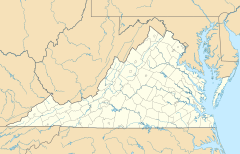Hog Island Light

Undated photograph of Hog Island Light (1896 tower) (USCG)
|
|
| Location | Hog Island SE of Exmore, Virginia |
|---|---|
| Coordinates | 37°23′38″N 75°42′04″W / 37.394°N 75.701°WCoordinates: 37°23′38″N 75°42′04″W / 37.394°N 75.701°W (approx.) |
| Year first lit | 1853 (first) 1896 (second) |
| Deactivated | 1896 (first) 1948 (second) |
| Construction | brick (first) cast iron (second) |
| Tower shape | conical (first) Octagonal pyramidal skeleton (second) |
| Height | 72 feet (first) 194 feet (second) |
| Original lens | (first) fourth-order Fresnel Lens first-order Fresnel Lens (second) |
| Range | 19 miles (17 nmi; 31 km) (second) |
| Characteristic | fixed white light (first) flashing white every 45 seconds (second) |
|
[]
|
|
The Hog Island Light was a lighthouse roughly marking its eponymous island, and thus the north side of the Great Machipongo Inlet on the Virginia coast. Originally, no light existed between Cape Henlopen, Delaware and Cape Charles, Virginia. In 1830 the United States Congress appropriated money for a coastal beacon in the general vicinity of Chincoteague Island. The following year, the Collector of Customs in Norfolk selected Assateague Island. In 1853 another lighthouse was erected twenty miles north of Cape Charles at Hog Island to light the remaining dark section of coastline between the Assateague Light and the entrance to the Chesapeake Bay.
There have been two lights at Hog Island, one of the Virginia Barrier Islands. The first light was erected in 1853 and consisted of a whitewashed brick tower with a keeper's dwelling adjacent to it. It was ostensibly equipped with a first-order fresnel lens, though a report in 1870 stated that it had been assigned a fourth order lens instead.
Erosion of the island eventually endangered the first lighthouse, and in 1896 an octagonal iron skeleton tower similar to the 1895 Cape Charles Light was erected to replace it. This new lighthouse, the second tallest in the United States at 194 feet, was built more than a half mile back from the ocean in a clearing in the dense pine forest that once covered most of Hog Island. The new Hog Island tower was painted black to distinguish it from the nearly identical Cape Charles light that is painted white. In 1900 early in the evening on Washington's Birthday a huge flock of birds, mostly geese and ducks, smashed into the lantern of the Hog Island Lighthouse. The two keepers fired their shotguns at the birds to drive them away before the lens was damaged. Two days later another flock of birds flew in. Out of ammunition, the keepers had to drive them away with sticks. This time much of the lantern glass was broken out and the light was extinguished until repairs were made.
...
Wikipedia

